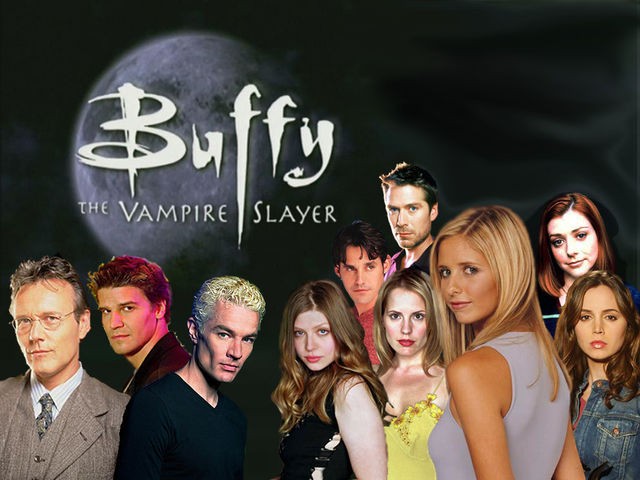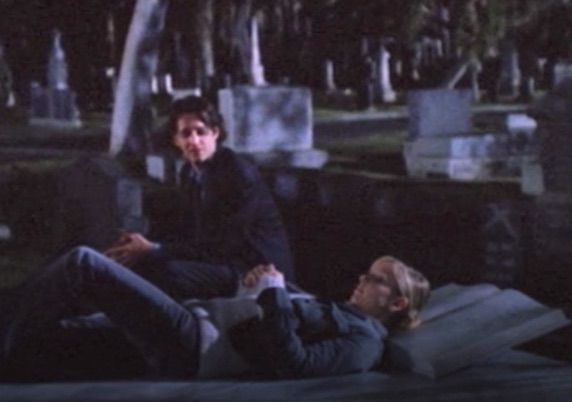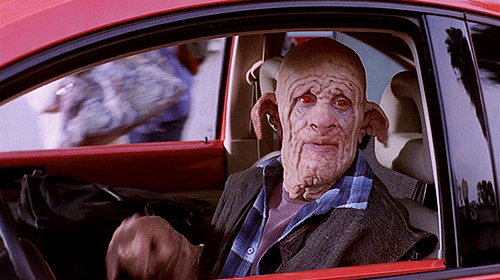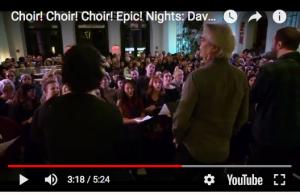
It’s kind of nuts that in the five years since we started blogging on metamodernism, we haven’t yet written about Buffy the Vampire Slayer as a seminal metamodern cultural product. Especially since, we might argue, Buffy is one of the television shows perhaps most influential to the metamodern sensibility. Created by Joss Whedon and starring Sarah Michelle Gellar, the popular television series ran from 1997 to 2003. It seemed that viewers and critics quickly learned it was more than just a show about a pretty high school girl who fights evil creatures in her spare time, because Buffy not only has a huge, thriving fandom, one that continues on more than a decade after it ended, but is also a topic of significant academic inquiry, with its own scholarly journal (Slayage).
So, you see, there’s almost too much to say, too many points linking Buffy and metamodern sensibilities. Almost any scene in any one of its 144 episodes across seven seasons could warrant a full treatment. Here we will delimit things by discussing three major elements of the series as a whole that we argue are metamodern. (If you’d like to read a lengthier essay, see “The Big Bad and the Big AHA: Metamodern Monsters as Transformative Figures of Instability” by WiM editor Linda Ceriello in Holy Monsters, Sacred Grotesques, Michael E. Heyes, ed., Lexington Books, 2018, or email us for a PDF — see sidebar for address.)
NOTE: If you came to this article for the Buffy discussion, and are not so familiar with metamodernism as a concept, read this, or for a shorter explanation, go to our home page, and skip down to the section with the heading “Right. So, what, according to us, is the basis for this term…”. Even shorter still: metamodernism can be taken as an episteme or cultural sensibility that, roughly around the year 2000, emerged from postmodernism, engaging the conflict between postmodern relativism and modernisms absolutism by emphasizing and protecting individual interiority and felt experience.
1) Monsters Are People Too
Although Buffy has very clear cut enemies – her mission, after all, is to destroy malicious vampires and demons – her tendency (and the show’s) is to seek out and respect the personhood of her opponents. One favorite example: In Season 7, Episode 7 (“Conversations With Dead People”), Buffy is out on her routine patrol in the local cemetery when she encounters a recently-undead vampire who turns out to have been Holden Webster (Jonathan Woodward), a guy she had taken European History with in high school. As they catch up on what became of various classmates, Buffy semi-reluctantly informs him that they will be fighting to the death. Between bouts of vicious combat, they share in a sort of late-night-insights-about-lifey way, engaging in some arm-chair psychologizing, with Holden offering several theories about why she has trouble maintaining relationships.
In the end, of course, she stakes him — it’s her job, and he’s an evil vampire. But with the metamodern sensibility that permeates Buffy the Vampire Slayer, there can simultaneously be a clear cut good/evil dichotomy and a certainty that everybody is a person with a story.
What’s more, in Buffy, and especially in its spin-off Angel, the vampires and demons have a culture. They have bars that they frequent, quotidian concerns, and a lot of the time they act like lovable dorks.
The character Angel and his rival Spike are both vampires who, at different times in the show, are good guys and bad guys, have souls and don’t, are Buffy’s lovers and enemies. At all times, however, they are depicted as having personal interiority that is significant in terms of moving the storylines along. The point emphasized is that everybody has interiority, and everybody’s interiority matters, including that of monsters.
The authors of this blog have argued elsewhere that this focus on their interiority is what distinguishes metamodern monsters from monsters in other epistemic categories. In comparison:
- In traditional or premodern tales, monsters are depicted to be real, or to have been real at some point in the accessible past. Monsters are indisputably evil and unidimensional, without nuance. Strong, courageous heroes are capable of slaying monsters, but there is an understanding that more monsters will rise again, requiring action by future heroes, as part of a natural cycle.
- In modernist stories, monsters are revealed via science or rational thought to be the product of trickery, deception or psychological projection. Or they are very clearly symbolic.
- In postmodern narratives, a confrontation with a “monster” raises questions about assumed categories and boundaries. Any attempt to “solve” the monster problem leads to more problems. Maybe we’re all monsters?
To be clear, not every demon in Buffy the Vampire Slayer is shown to have interiority. Some get staked before they utter a word. The show includes all of the epistemic layers, but the metamodern is the most dominant.
2) Buffyspeak
After watching a few episodes of the show, it becomes clear that Buffy and her friends – the “Scoobies” – have a unique way of talking. It’s a teeny bit evocative of “Valley Girl” speech, but it’s really mostly its own thing. No less than the blog of the Oxford English Dictionary has weighed in on the way the show uses its invented speech patterns. What Bonnie Kneen of the OED blog seems to be saying is, basically, “What’s up with all the metamoderniness?”
… I think that Buffy – with its giddy language games and its cultivated diction, as much as its lightweight adolescent backdrop and its steady exploration of what it means to be ethical, to be human, to find meaning in being – perhaps calls into question the idea that slight and substantial, ephemera and art, language and content are mutually exclusive just because we tend to treat them as binary opposites.
In our own words: There’s something in the quirky absurdity, the disarming youthfulness, the special way that Buffy and her friends talk that feels necessary in order to hold and express the ultra-suchness of their interiority. Adjectives are turned into nouns (and vice versa), suffixes are doubled up or applied where normal English speakers would not apply them. Everything is “a thing.”
“I don’t like this whole no-mouth thing. It’s disquieting.” – Willow
“This is great long-term-planny stuff, but what about this key thingy Glory’s looking for?” – Xander
“We thought you’d get lots of crossbows and other killy stuff.” – Tara
“Lurk much?” – Dawn
“I’m the slayer. The chosen one. How mythic and defendery.” – Buffy
3) Dawn
One of the most unusual components and weirdest arcs in Buffy the Vampire Slayer is the sudden introduction of Buffy’s little sister, Dawn (Michelle Trachtenberg), at the beginning of Season 5. For those who have not watched the show, basically an “inter-dimensional key” was transformed into a teenage human and inserted into Buffy’s life in order to protect the key from malevolent forces. For several episodes after Dawn’s introduction, the characters are apparently oblivious to the fact that she hadn’t always been there. The monks who created Dawn from the key also have retconned memories into everyone she comes in contact with so that they believe Buffy has always had a little sister. After a while, Buffy learns the truth, then tells the other Scoobies, and when Dawn finally finds out she is not actually a regular human, she is understandably disturbed and distraught.
Mom: Honey, you’re gonna be late for school.
Dawn: I’m not going. Blobs of energy don’t need an education.
Buffy’s reassurance to Dawn that they share family blood and they are true-sisters-no-matter-what (“There’s no way you could annoy me so much if you weren’t”) can be seen as a powerfully metamodern response to a postmodern existential crisis: Dawn’s identity has been deconstructed, but Buffy reconstructs it by choosing the narrative that includes Dawn as a real person.
With a reboot of Buffy the Vampire Slayer on its way, it will be interesting to see whether it includes a lot of the elements that made us feel the original series was so exemplary of metamodernism, or if it goes in an entirely new direction.
*****
Interested in the metamodernism of Joss Whedon’s work? You may also like:
Joss Whedon’s Dollhouse: A Metamodern Negotiation of the Real




